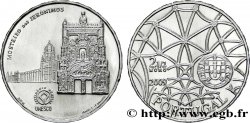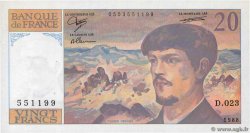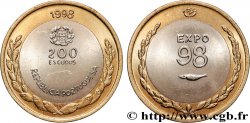E-auction 608-584210 - fwo_947012 - PORTUGAL 200 Escudos Exposition Universelle de Lisbonne - Expo 98 1998
得先注册又得到批准才可以报价。为了报价注册. 客户应该得到公司允许,那种过程需要 48 个小时。别等出售结束那一天才登记。您报价的话等于您赞成买那物品,而且按« 保价 » 证明您接受 cgb.fr 因特网拍卖使用法.
报价时只可以出全数值欧元总额。物品描述也说明销售结束时间,结束后出价都不会生效。 报价命令转达有时变动,等到最后秒钟增加否决的可能会。想多了解的话请注意 因特网拍卖常问
购货人不付费
购货人不付费
| 估算 : | 9 € |
| 价格 : | 2 € |
| 最高出价 : | 2 € |
| 拍卖结束日期 : | 09 December 2024 17:45:20 |
| 竞拍人 : | 2 竞拍人 |
种类 200 Escudos Exposition Universelle de Lisbonne - Expo 98
日期: 1998
铸币数量 50000
材质 bi-metallic
直径 28 mm
模子方针 6 h.
重量 9,86 g.
侧面 séries de cannelures
出版目录中的项代码 :
正面
正面的文字 1998 // 200 / ESCUDOS // REPUBLICA PORTUGUESA.
正面的说明书 emblème du Portugal, couronne faite de poissons.
背面
背面的文字 EXPO / 98.
背面的说明书 poisson, couronne faite de poissons.
评论
Les expositions universelles ont été créées pour présenter les réalisations industrielles des différentes nations. Elles représentaient la vitrine technologique et industrielle des participants, témoignant du progrès au cours de la révolution industrielle. La première exposition universelle s'est déroulée à Londres en 1851.
À l'origine, chaque pays disposait d'un espace réservé dans un pavillon central. À partir de 1867, des pavillons nationaux firent leur apparition. En principe, ils étaient attribués seulement s'il y avait des choses à présenter que le pavillon central ne pouvait accueillir. Ils ne tardèrent pas à se généraliser, les nations exposantes construisant des pavillons typiques de l'architecture de leurs pays.
La compétition était omniprésente dans les expositions universelles, et des concours permettaient aux plus méritants d'obtenir des médailles bénéficiant d'un certain prestige.
De nombreuses réalisations architecturales construites à l'occasion d'expositions universelles sont devenues par la suite des symboles des villes qui les ont abritées : la tour Eiffel à Paris, l'Atomium à Bruxelles, le Space Needle à Seattle, la Biosphère à Montréal.
Enfin, la tenue des expositions universelles a toujours été l'occasion de mettre en place des projets d'urbanisme : construction du métro de Paris en 1900 ou celui de Montréal en 1967, extension du métro de Lisbonne en 1998…
Voir http://fr.wikipedia.org/wiki/Exposition_universelle .
World's Fairs were created to showcase the industrial achievements of different nations. They represented the technological and industrial showcase of the participants, testifying to progress during the industrial revolution.. The first World's Fair took place in London in 1851..
Originally, each country had a dedicated space in a central pavilion. From 1867, national pavilions appeared. In principle, they were only allocated if there were things to be presented that the central pavilion could not accommodate.. They soon became widespread, with exhibiting nations building pavilions typical of the architecture of their countries..
Competition was omnipresent at world fairs, and competitions allowed the most deserving to obtain medals that carried a certain prestige..
Many architectural achievements built for world exhibitions have subsequently become symbols of the cities that hosted them: the Eiffel Tower in Paris, the Atomium in Brussels, the Space Needle in Seattle, the Biosphere in Montreal..
Finally, the holding of universal exhibitions has always been an opportunity to implement urban planning projects: construction of the Paris metro in 1900 or that of Montreal in 1967, extension of the Lisbon metro in 1998… See http://fr. Wikipedia. org/wiki/Exposition_universelle
À l'origine, chaque pays disposait d'un espace réservé dans un pavillon central. À partir de 1867, des pavillons nationaux firent leur apparition. En principe, ils étaient attribués seulement s'il y avait des choses à présenter que le pavillon central ne pouvait accueillir. Ils ne tardèrent pas à se généraliser, les nations exposantes construisant des pavillons typiques de l'architecture de leurs pays.
La compétition était omniprésente dans les expositions universelles, et des concours permettaient aux plus méritants d'obtenir des médailles bénéficiant d'un certain prestige.
De nombreuses réalisations architecturales construites à l'occasion d'expositions universelles sont devenues par la suite des symboles des villes qui les ont abritées : la tour Eiffel à Paris, l'Atomium à Bruxelles, le Space Needle à Seattle, la Biosphère à Montréal.
Enfin, la tenue des expositions universelles a toujours été l'occasion de mettre en place des projets d'urbanisme : construction du métro de Paris en 1900 ou celui de Montréal en 1967, extension du métro de Lisbonne en 1998…
Voir http://fr.wikipedia.org/wiki/Exposition_universelle .
World's Fairs were created to showcase the industrial achievements of different nations. They represented the technological and industrial showcase of the participants, testifying to progress during the industrial revolution.. The first World's Fair took place in London in 1851..
Originally, each country had a dedicated space in a central pavilion. From 1867, national pavilions appeared. In principle, they were only allocated if there were things to be presented that the central pavilion could not accommodate.. They soon became widespread, with exhibiting nations building pavilions typical of the architecture of their countries..
Competition was omnipresent at world fairs, and competitions allowed the most deserving to obtain medals that carried a certain prestige..
Many architectural achievements built for world exhibitions have subsequently become symbols of the cities that hosted them: the Eiffel Tower in Paris, the Atomium in Brussels, the Space Needle in Seattle, the Biosphere in Montreal..
Finally, the holding of universal exhibitions has always been an opportunity to implement urban planning projects: construction of the Paris metro in 1900 or that of Montreal in 1967, extension of the Lisbon metro in 1998… See http://fr. Wikipedia. org/wiki/Exposition_universelle








 对产品描述纠错
对产品描述纠错 打印
打印 分享我的选择
分享我的选择 提问
提问 Consign / sell
Consign / sell
 产品介绍
产品介绍














